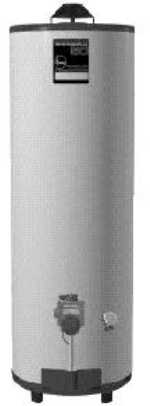Search engine visitors - click here to access entire "$ensible Home" web site
Click here to see a descriptive illustration of a cutaway of a hot water heater.
Dear Jim: Our old gas water heater does not leak yet, but we seem to run out of hot water sooner than we used to. Is there any type of simple water heater tune-up that I can do myself to get more hot water? - Pat H.

A: Your old, out-of-tune gas water heater is not only leaving you with cold morning showers, but it is costing you a bundle in excessive water heating costs. Heating water typically accounts for 15% to 20% of your utility bills.
Doing a simple tune-up and making low-cost improvements, like adding an insulation wrap, will increase the hot water volume. The savings will also pay back the costs in a year. Even Wall Street cannot beat this return.
If your water heater is more than 15 years old, first check it carefully for signs of small leaks. If you find any it must be replaced. This is not really so bad because the new super-efficient designs are quiet and provide more hot water. The utility bills savings will also be substantial.
Assuming you found no signs of leaks, drain several gallons of water from the valve near the bottom of the tank. Don't worry - the water at the bottom is not very hot. Do this every month in hard water areas.
This removes some of the sediment that settles to the bottom of the tank. A several-year-old thick layer of sediment insulates the hot burner from the water. This results in less hot water output and a slower recovery rate.
Feel the top portion of the side of the water heater tank. If it feels warm, add an insulation jacket. Make sure to allow for clearance around the draft hood at the top and the combustion air inlet near the bottom.
If your water heater does not have heat trap pipe fittings (one-way valves), insulate the vertical sections of the water pipes above the water heater. Insulate both the hot and cold pipes.
Most new heaters come with heat trap fittings. If you can solder a copper pipe, you can install them in your old water heater. These are very cheap and install where the water pipes attach to the water heater. These block the slow energy-wasting back circulation of hot water into the pipes.
There are several possible causes of reduced hot water to troubleshoot yourself. The thermostat may have accidentally been set lower. Check the hot water temperature at the nearest faucet. It should be 120 degrees.
The burner orifice may be dirty which results in less heat and longer recovery times. Check it by looking at the flames. They should be steady and blue, not yellow. Cleaning requires a service call.
Instant Download Update Bulletin No. 511 - a gas water heater troubleshooting guide, tips for mainting and using your water heater efficiently, water and energy conservation tips, diagram of common features of a gas water heater and a listing of high-output, efficient gas water heaters and heat trap fittings.
Dear Jim: I am getting older and I need brighter light to see. I hear that more people are using daylighting in their homes. What does daylighting mean and is it a better source of light? - Lana T.
A: Daylighting refers to using natural light (not lamps) in your home. This is often done with traditional skylights, skylight tubes, larger windows and more open floor plans.
Daylighting is usually used to reduce electric bills and to protect the environment from excessive fossil fuel use. Contact your physician to determine if the full-spectrum natural light is better for your eyes.